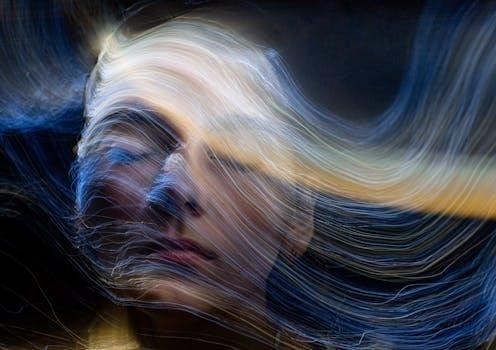Definition of Yellowface
What is Yellowface?
Yellowface is a practice where non-Asian actors portray characters of Asian descent․ This often involves using makeup to alter skin tone and appearance, aiming to mimic East Asian features․
What is Yellowface?
Yellowface is a form of theatrical makeup and performance where non-Asian individuals, often white actors, portray characters of East Asian descent․ This involves using makeup to alter skin tone, often creating a yellow hue, and employing prosthetics to mimic facial features․ The practice is deeply rooted in historical misrepresentations and stereotypes․ This act is not only about applying makeup; it often includes exaggerated mannerisms, accents, and costumes, which all contribute to a harmful and inaccurate portrayal of Asian people․ Yellowface is considered a form of racial mimicry, similar to blackface, and has a long history in theatre, film, and other media․

Historical Context of Yellowface
The practice of yellowface emerged in the 19th century within American theater․ White performers would use makeup to represent Asian characters, often in stereotypical ways․
Early Instances in Theater and Film
Early examples of yellowface can be traced back to the 19th century, predominantly in American theater․ During this period, white actors would routinely portray Asian characters, employing makeup to alter their facial features and skin tone․ These performances often relied on exaggerated and stereotypical representations of Asian people, contributing to the formation of harmful and inaccurate cultural perceptions․ This practice was widespread, becoming a common feature in theatrical productions․ The use of yellowface in these early performances established a problematic precedent for the representation of Asian individuals in media, setting the stage for its continued use in later forms of entertainment, including the burgeoning film industry․
Yellowface in Hollywood’s Golden Age
The practice of yellowface persisted into Hollywood’s Golden Age, becoming a normalized aspect of film production․ White actors continued to be cast in Asian roles, often employing makeup and prosthetics to achieve a stereotypical Asian appearance․ This era solidified the use of yellowface as a standard practice, further perpetuating harmful stereotypes on a larger scale through the influence of cinema․ These portrayals frequently depicted Asian characters as either submissive or villainous, reinforcing prejudiced views․ The lack of authentic representation during this period significantly contributed to the mischaracterization and dehumanization of Asian people in popular culture, solidifying a problematic legacy for future generations․

Techniques and Elements of Yellowface
Yellowface often employs makeup to alter skin tone․ Prosthetics are sometimes used to change facial features, aiming for a stereotypical East Asian appearance, further distorting reality․
Use of Makeup and Prosthetics
The core of yellowface often lies in the application of makeup to transform a non-Asian actor’s appearance․ This typically involves using yellow-toned foundations, powders, and other cosmetics to create a skin tone that is perceived as “Asian․” Furthermore, the use of prosthetics plays a crucial role, frequently altering the shape of the eyes, nose, and other facial features to achieve a stereotypical East Asian look․ This combination of makeup and prosthetics aims to visually “other” the actor, reinforcing harmful and inaccurate representations of Asian people․
Exaggerated Mannerisms and Accents
Beyond physical alterations, yellowface frequently incorporates exaggerated mannerisms and accents to reinforce stereotypes․ Actors often adopt exaggerated speech patterns, mimicking what is perceived as an “Asian accent,” which is not only inaccurate but also deeply offensive․ These caricatures extend to physical movements, often portraying Asian characters as subservient, awkward, or comical․ This layering of exaggerated behaviors on top of altered physical appearances further perpetuates harmful stereotypes and reduces complex cultures and individuals to simplistic, offensive tropes․ This theatricality contributes to the dehumanization of Asian people․
Impact and Criticism
Yellowface perpetuates harmful stereotypes by reducing diverse Asian cultures to simplistic caricatures․ This practice reinforces negative and inaccurate portrayals, impacting how Asian people are viewed․
Perpetuation of Stereotypes
The use of yellowface in media has consistently perpetuated harmful stereotypes about Asian people․ This practice often reduces complex cultures and diverse individuals to one-dimensional caricatures, reinforcing inaccurate and often offensive tropes․ These stereotypes can range from portraying Asian characters as submissive and docile to portraying them as villainous and cunning․ Such representations not only misinform audiences but also contribute to prejudice and discrimination against Asian communities, both in media and real life․ The continued use of yellowface undermines efforts to promote accurate and respectful portrayals of Asian people․
Harmful Cultural Misrepresentations
Yellowface leads to harmful cultural misrepresentations by presenting a distorted and inaccurate view of Asian cultures․ It often conflates diverse ethnicities and traditions into a single, homogenous stereotype․ This misrepresentation not only erases the richness and complexity of Asian cultures but also denies individuals their unique cultural identities․ Furthermore, yellowface can lead to the trivialization of cultural practices and symbols, which can be deeply offensive and disrespectful to the communities they represent․ These harmful misrepresentations contribute to a lack of understanding and appreciation of Asian cultures, perpetuating ignorance and prejudice․
Yellowface in Modern Media
Even today, yellowface appears in modern media, often sparking significant controversy․ This includes instances in film, television, and even digital platforms, continuing a harmful tradition․
Contemporary Examples and Controversies
Modern examples of yellowface often involve casting non-Asian actors in Asian roles, sometimes with the use of makeup or prosthetics to alter their appearance․ This practice has faced significant backlash, with many criticizing it as a continuation of harmful stereotypes․ The use of CGI to create digital yellowface is another controversial issue, raising questions about authenticity and representation․ These contemporary examples highlight the ongoing struggle for accurate portrayals of Asian characters in media, with audiences and critics demanding more respectful and genuine casting choices․ The discussion surrounding these examples underscores the need for greater awareness and change․
Digital Yellowface and CGI
The emergence of digital technology has introduced a new dimension to yellowface, with CGI being used to alter actors’ features to appear more Asian․ This practice, often referred to as digital yellowface, raises ethical questions about the creation of artificial representations and the perpetuation of stereotypes․ The use of CGI to modify actors’ appearances can be seen as a way to avoid casting Asian actors, further contributing to the lack of representation in the media․ This practice is considered controversial and disturbing, as it is viewed as an attempt to sidestep the need for authentic casting, raising concerns about dehumanization and misrepresentation․
Related Practices
Yellowface is often compared to blackface and other forms of racial mimicry, all of which involve non-minority individuals adopting the stereotypical characteristics of other ethnic groups․
Comparison to Blackface and Other Racial Mimicry
Yellowface shares a troubling parallel with blackface, brownface, and redface, all representing forms of racial mimicry where individuals from a dominant group adopt exaggerated or stereotypical features of marginalized groups․ These practices are not merely about impersonation; they are rooted in historical power imbalances and often serve to perpetuate harmful stereotypes․ Like blackface, which mocked African Americans, yellowface caricatures Asian individuals, reinforcing dehumanizing and inaccurate representations․ These forms of racial performance are deeply problematic, contributing to cultural misrepresentation and reinforcing discriminatory attitudes․ They all highlight the dangers of reducing complex ethnic identities to superficial and often offensive caricatures․

Linguistic Aspects
The term “yellowface” is a compound word combining “yellow” and “face,” referencing the practice of using makeup to create an East Asian appearance․ It emerged in English usage․
Origin and Etymology of the Term
The term “yellowface” is formed by combining the words “yellow” and “face,” directly referencing the practice of altering one’s facial appearance to resemble that of an East Asian person․ This term emerged within the English language, reflecting a need to describe the specific phenomenon of non-Asian performers using makeup and other means to portray Asian characters․ The word’s etymology is straightforward, highlighting the visual aspect of the practice, the use of makeup to make someone’s face appear yellow․ The Oxford English Dictionary first recorded its usage in 1959, suggesting a more recent formalization of a practice that had been ongoing for many years prior․
Usage and Frequency in Modern English
The term “yellowface” is used in modern English primarily within discussions of race, representation, and media․ While it’s not a word found in everyday casual conversation, it appears frequently in academic writing, journalistic articles, and social commentary relating to theater, film, and other forms of performance․ Its usage is increasing as awareness grows about issues of cultural appropriation and misrepresentation․ While not extremely frequent, “yellowface” occurs approximately 0․06 times per million words in modern written English, demonstrating its presence in the lexicon when discussing racial performance․ This usage reflects a growing scrutiny of historical and contemporary practices․

Yellowface in Literature
Rebecca F․ Kuang’s novel, ‘Yellowface,’ explores themes of cultural appropriation, and literary deceit․ The book examines the complexities of identity in publishing․
Analysis of the Book ‘Yellowface’ by Rebecca F․ Kuang
R․F․ Kuang’s “Yellowface” delves into the competitive world of publishing, exploring themes of cultural appropriation and personal ambition through the lens of two writers․ The novel highlights the complexities of identity, examining how a white author’s actions impact the literary landscape․ It questions the nature of success and the lengths people go to attain it in the literary world․ Kuang’s novel also examines the fetishization of diverse voices․ The book also offers a suspenseful and thrilling narrative, while raising important questions about representation and authenticity in literature․
Understanding yellowface is crucial for promoting inclusivity and authentic representation․ Awareness leads to change, encouraging responsible casting and storytelling that avoids harmful stereotypes and misrepresentations․
The Importance of Awareness and Change
Recognizing and understanding yellowface is paramount in fostering a more inclusive and equitable media landscape․ This awareness enables us to critically analyze portrayals and actively challenge the perpetuation of harmful stereotypes․ By acknowledging the historical context and negative impact of yellowface, we can advocate for authentic representation and diverse storytelling․ It’s essential to support creators from marginalized communities, giving them the platform to share their own narratives․ This shift not only enriches our cultural understanding but also promotes respect and empathy for all․ Ultimately, change requires continuous education and a conscious effort to dismantle prejudiced practices․

Leave a Reply
You must be logged in to post a comment.